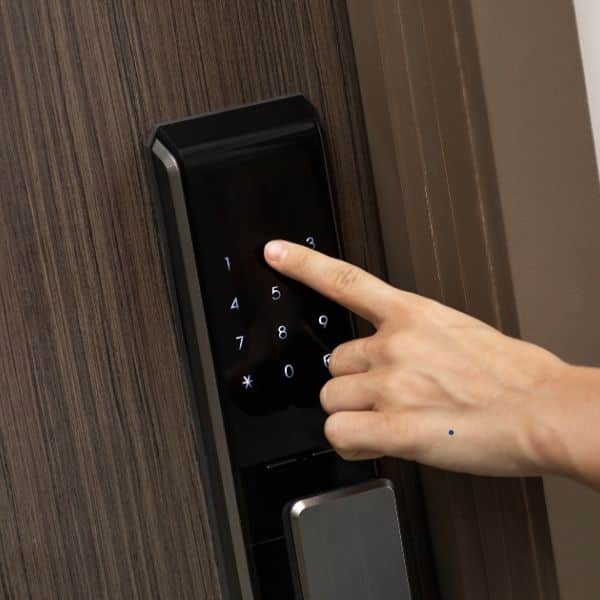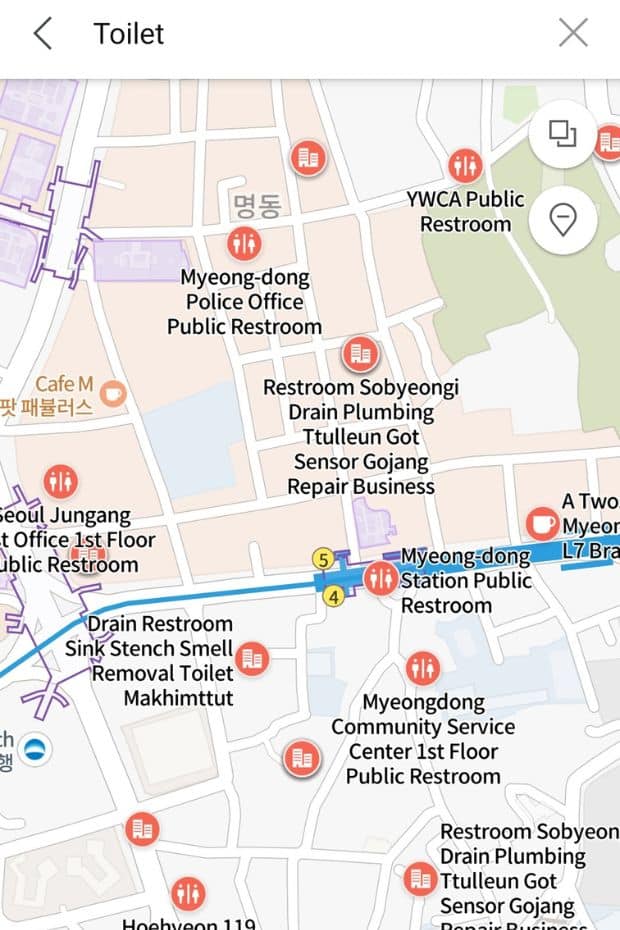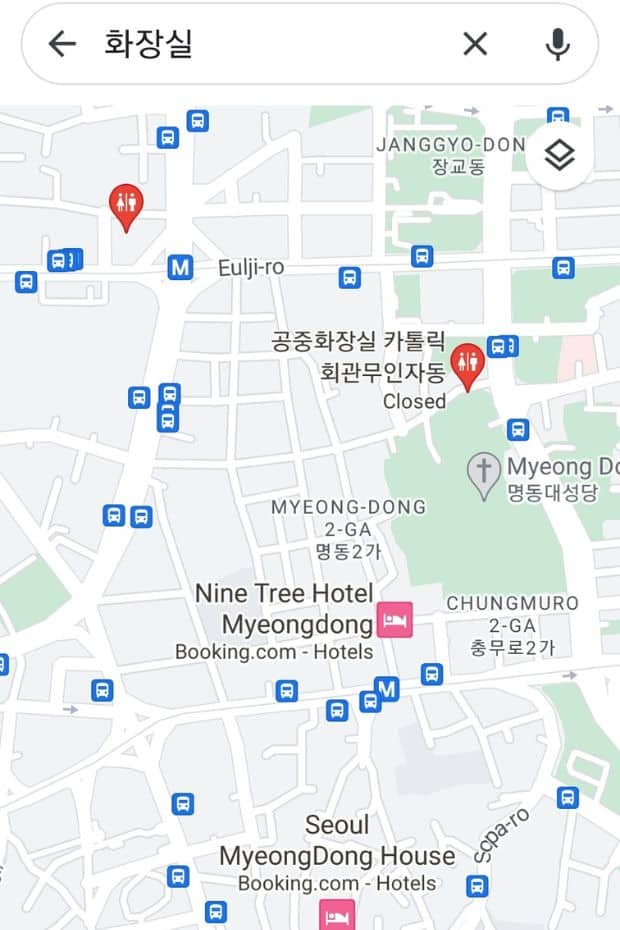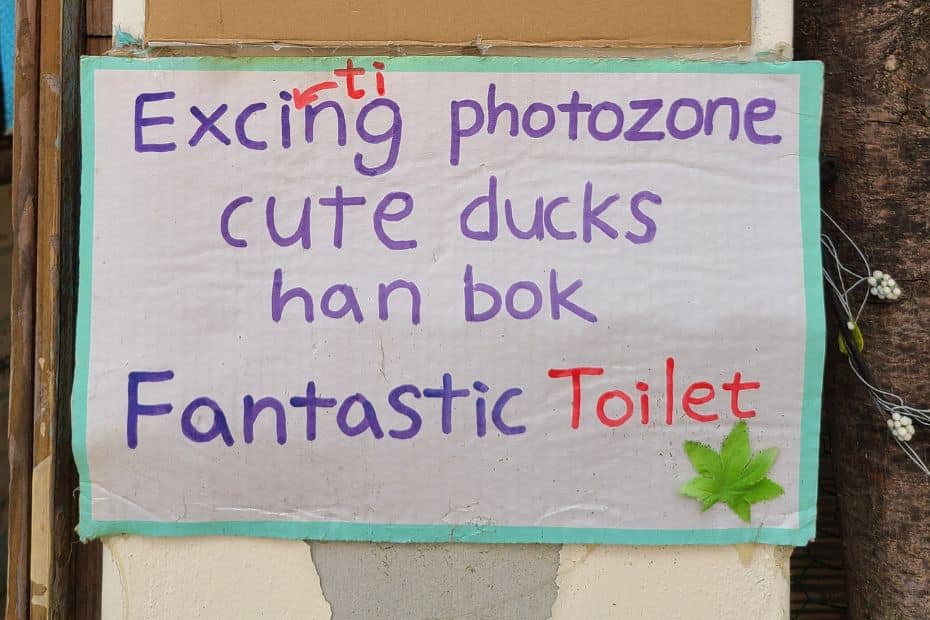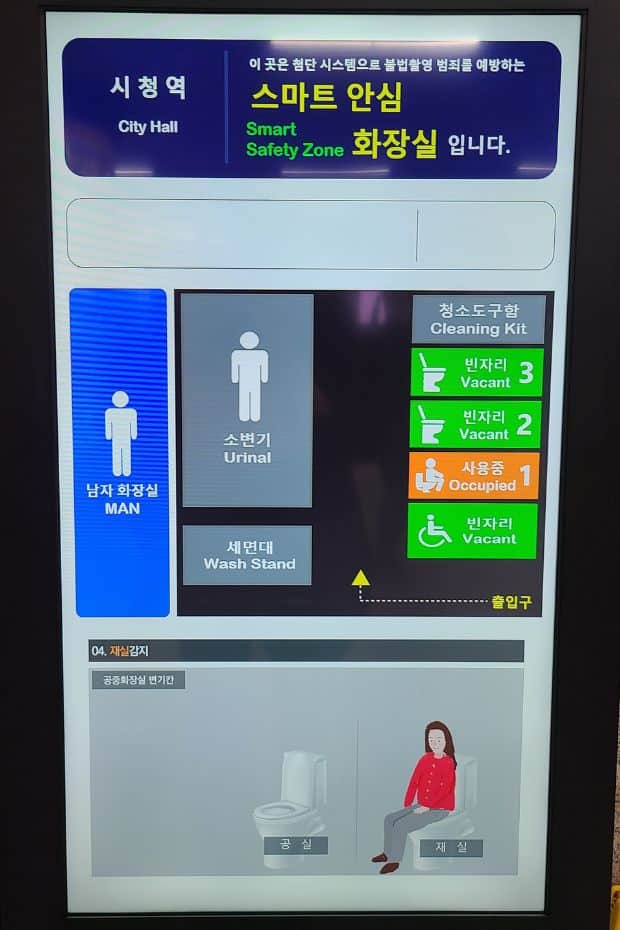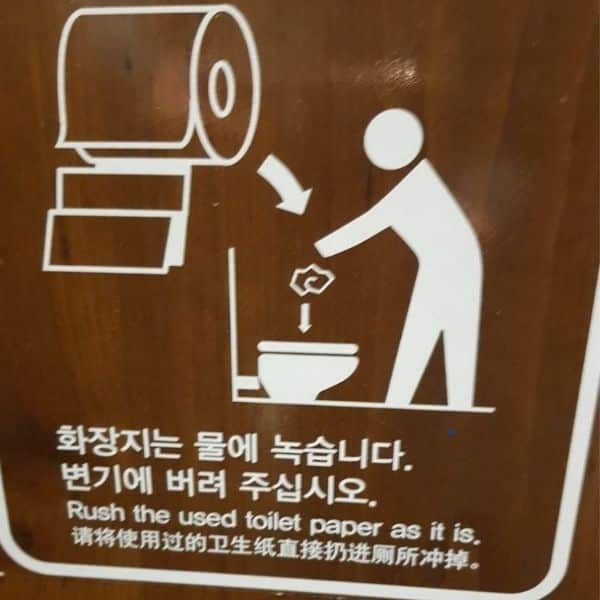Planning to travel to Korea soon and concerned about what Korean public toilets are like? Stuck in Seoul and need to find a restroom, but not sure where to go? Want to know why Korean toilets have metal bins in them and how two Olympics changed Korean toilet culture in very different ways? Then this article all about Korean public toilets is for you.
Korea’s restrooms are a mixed bunch and include everything from high-tech heated toilet seats to traditional squat toilets that might make some people uncomfortable. This article covers all there is to know about going to the toilet in Korea, what to watch out for in public restrooms, and lots more.
If you want some interesting cultural insights about Korean toilet culture, then check out the ‘insights‘ section or use the links in the table of contents below. Otherwise, I hope this article will provide lots of useful information about Korean public toilets, including how to find them and what they’re like.
Affiliate Disclaimer: This site contains affiliate links and I may earn commission for purchases made after clicking these links.
What Are Public Toilets In Korea Like?
What are public toilets in Korea like? Are they clean and luxurious or dirty and disgusting? Are Korean toilets the same as in other countries such as the USA or Singapore, or modern marvels like you’ll find in high-tech Japan? Well, they’re all of the above and generally not too bad. Mostly.
This article introduces you to the different types of toilets you’ll encounter in Korea, show where to find public toilets in Korea, prepare you for likely toilet surprises, offer some toilet etiquette tips, and give you insights into using public restrooms while travelling in Korea. Essential reading for sure.
Travelling to another country, especially one that might be in a different continent, can be exciting and daunting in equal measures. You’re about to discover a world of new experiences, places, tastes, sights, sounds, and faces, but also a world of surprises that come with a unique culture.
You’ve planned out what to see and do in Seoul and beyond, but one thing you might not have considered is what to do when you need the loo. Or perhaps you have, which is why you’re reading this guide to Korean public toilets. Either way, going to the toilet in Korea is going to be an experience.
Different Types Of Korean Toilets
Toilets in Korea fall into one of three different categories, ranging from heated seats that you won’t want to leave (especially during winter), to knee-aching holes in the floor that will test your yoga poses. Here are the different types of toilets in Korea, all of which can be found in Korean restrooms.
Luxury Electric Toilets: The king of toilets. This is a wonderful modern toilet that originated in Japan in the 1980s. This toilet features an electronic bidet that has a range of functions, including various sprays for cleaning certain areas, a fan for drying those areas, automatic flushing, and heated seats.
Standard Flush Toilets: The most common type of toilet in Korea’s public restrooms is the standard flush toilet that is used around the world. This is what many people have in their homes if they haven’t splashed out on an electronic bidet. Almost all public restrooms in Korea will have one of these.
Basic Squat Toilets: These are the traditional squat toilets that are basically a ceramic hole in the ground that you do your business into. These toilets don’t have a seat, hence the name. You can find squat toilets across Korea and they’re still used in many countries in Asia and other places.
Which Toilets Are Common In Korean Public Restrooms?
Korean public restrooms mostly have flush toilets with a seat and flush (handle or button) in a stall. For male restrooms, urinals are the same as you’ll find in other countries. Some public toilets may have electronic bidets, but these are usually reserved for disabled toilets and some wealthier areas.
Squat toilets are also still common in public bathrooms in Korea, although they aren’t as common as flush toilets. Public toilets in Korea will usually have one squat toilet for every two or three flush toilets. Electronic bidets aren’t common in public restrooms, but you might find them in department stores.
Public toilet stalls in Korea usually have a sign outside to show you which type of toilet is inside. The picture above shows the sign for a squat toilet (sometimes called an oriental water closet) at a subway station in Daejeon. Standard toilets and electronic bidets will have a picture of a flush toilet.
I’ll provide more information about what Korean toilets are like inside later on in this article. I’ll explain more about Korea’s toilet hygiene, safety, convenience, and comfort so you know what to expect. The first challenge, however, is being able to find a public toilet in Korea, which is covered next.
Planning to visit Korea? These travel essentials will help you plan your trip, get the best deals, and save you time and money before and during your Korean adventure.
Visas & K-ETA: Some travellers to Korea need a Tourist Visa, but most can travel with a Korean Electronic Travel Authorisation (K-ETA). Currently 22 Countries don’t need either one.
How To Stay Connected: Pre-order a Korean Sim Card or a WiFi Router to collect on-arrival at Incheon Airport (desks open 24-hours). Alternatively, download a Korean eSIM for you travels.
Where To Stay: For Seoul, I recommend Myeongdong (convenient), Hongdae (cool culture) or Gangnam (shopping). For Busan, Haeundae (Beach) or Seomyeon (Downtown).
Incheon Airport To Seoul: Take the Airport Express (AREX) to Seoul Station or a Limo Bus across Seoul. Book an Incheon Airport Private Transfer and relax to or from the airport.
Korean Tour Operators: Tour companies that have a big presence in Korea include Klook, Trazy, Viator, and Get Your Guide. These sites offer discounted entry tickets for top attractions
Seoul City Passes: Visit Seoul’s top attractions for free with a Discover Seoul Pass or Go City Seoul Pass. These passes are great for families and couples visiting Seoul – you can save lots.
How To Get Around: For public transport, grab a T-Money Card. Save money on Korea’s high speed trains with a Korea Rail Pass. To see more of Korea, there are many Rental Car Options.
Travel Money: Use money exchanges near Myeongdong and Hongdae subway stations for the best exchange rates. Order a Wise Card or WOWPASS to pay by card across Korea.
Flights To Korea: I use flight comparison sites such as Expedia and Skyscanner to find the best flights to Korea from any country. Air Asia is a good option for budget flights from Asia.
How To Learn Korean: The language course from 90 Day Korean or Korean Class 101 both have well-structured lessons and lots of useful resources to help you learn Korean.
Where To Find Public Toilets In Korea
If you need to find a public toilet in Korea, the best option is to head to a train or subway station and use the facilities there. These public toilets are cleaned regularly, are free to use, and have a large enough capacity to handle many people at once. They are open as long as the station is open.
Public restrooms in Korean train or subway stations will have a mixture of squat and flush toilets, as well as disabled toilets. The stations in large cities, such as Seoul, Busan, Incheon, Daejeon, and Gwangju, will have perfectly acceptable toilets that are fine to use. Toilet rating 4/5.
If you’re not near a train or subway station, here are some other places you can find a public toilet in Korea. Some of these aren’t open to the general public, but you can get away with using them anyway and people in Korea will do so if they need to. Some toilets will have a pass-code.
Shopping Malls: High-end shopping malls in Korea have the best toilets and if you’re near one, this is the best place to go to the toilet. Department stores such as Shinsegae, Galleria, Lotte, or Hyundai usually have toilets with electronic bidets, regular cleaning, and great facilities. Toilet rating: 5/5.
Tourist Attractions: Travellers in Seoul can breathe a sigh of relief when planning a busy day out sightseeing. Tourist attractions, including Seoul’s palaces, museums, and galleries, generally include clean and modern toilets. If you pay an entry fee, there’s usually a toilet. Toilet rating 4/5.
Bus Terminals: Like train and subway stations, bus terminals are equipped with restrooms that can handle a large number of people. However, in my experience travelling in Korea, bus terminal toilets aren’t as nice as train and subway station restrooms and are typically older. Toilet rating 3/5.
Cafes: Cafes in Korea will either have toilets inside the cafe (if it’s a standalone building) or there will be toilet access in the building (more common). These toilets are locked and you need a code to enter them, which is usually on the door, on the counter, or printed on your receipt. Toilet rating 3/5.
Restaurants: As with cafes, restaurants usually have shared toilets with the rest of the businesses in the building. This is common in Korea and they require a passcode (4 digits) found inside the restaurant. Beware, you might need to ask for toilet paper for these toilets. Toilet rating 3/5.
Public Parks: In case of an emergency, head to a public park in Korea and you should be able to find a toilet (pictured above). However, public restrooms in parks are a gamble and can range from clean and modern to… not so clean. They’re generally safe and have all you need. Toilet rating 3/5.
Car Parks: Another last resort, car parks in Korea might (not always) have a public toilet available for people using the car park (or passing through). The cleanliness and comfort of these toilets depends on the location and countryside car parks can be rather basic. Toilet rating 2/5.
Travellers to Japan may be aware that Japanese convenience stores have toilets that customers can use when they visit the store. While Korea has many thousands of convenience stores, none of these offer toilets. They offer almost everything else, but you can’t rely on them when you need to go.
How To Use Naver Map To Find Korean Public Toilets
The most reliable way to find a public toilet in Korea is to use Naver Map. Use the search function at the top of Naver Map to search for 화장실 (hwa-jang-shil), the Korean word for restroom. You can also search for ‘toilet’ in English. Both searches return the same results (see pictures below).
However, it’s important to note that these toilets aren’t all public toilets and you may not be able to use them. As mentioned, some Korean toilets are available for everyone, but some may have door codes or be inside cafes. The toilet in ‘A Twosome Place’ (below) is likely to be closed to non-customers.
Can you use Google Maps to search for toilets in Korea? Unfortunately, Google Maps isn’t very effective in Korea and often returns unreliable data. It doesn’t show subway lines and the display is not as user friendly as Naver Map, which is why I recommend Naver Map for directions in Korea.
The screenshot below is a search in Korean for toilets in the same area (Myeongdong) as the Naver Map searches above. As you can see, not only does the map look more basic and less useful, there are also far fewer search results available. It doesn’t even show the Myeongdong Station toilet.
To be able to use Naver Map and other Korean applications as you travel in Korea, you’ll need to have access to the Internet. There is lots of free public WiFi in Seoul and other cities, which is really useful, but if it’s an emergency, you might not want to wait to find a good signal.
I recommend getting a Korean sim card for your phone and installing it when you arrive at Incheon Airport. This will allow you to use Korean apps, make reservations (phone numbers are required for these in Korea), get food delivered, book and pay for taxis with Kakao Taxi, and more.
Where To Find Public Toilets In Seoul
The best place to find public toilets in Seoul are at major train stations or subways stations. These are spread out across the city, so you should be able to find one nearby. If you plan to use the subway to travel in Seoul, I recommend using the toilets during your journey while you have a chance.
Tourist attractions such as Gyeongbokgung Palace, N Seoul Tower, Lotte World Tower, and Jogyesa Temple will also have restrooms which are open to visitors or people passing by. It’s not easy to find public restrooms in areas such as Bukchon Hanok Village, so you may need to go to a cafe.
If you’re exploring popular districts in Seoul, such as Hongdae, Gangnam, or Myeongdong, head to a shopping mall, department store, or subway station to use the public bathrooms there. When you stop for a coffee or meal, use the facilities there as you won’t be able to find them on the street as easily.
Public Toilets Outside Of Seoul
In Korean cities outside of Seoul, the same rules apply for locating a public toilet. Head to a train or subway station for the most accessible public restrooms. Daejeon, Busan, Incheon, and Gwangju all have a subway system in the city and a train station in or near the centre.
Less touristy cities, such as Daejeon and Gwangju, may not have as many public toilets as they’re not used to catering to large numbers of tourists. In areas such as Haeundae Beach in Busan, there will be more public restrooms as there are more visitors, both Korean and foreign tourists.
The quality of restrooms in Korean cities will vary depending on the overall level of development in that city. For example, in central Daejeon, there are typically well maintained public toilets, but on the outskirts of the city, particularly in less wealthy neighbourhoods, the facilities aren’t as modern.
As for the Korean countryside, you may have a hard time finding public toilets. The best options are bus terminals, cafes, and restaurants, as well as any shopping or outlet malls that might be around. Be sure to use facilities when you can, especially if you’re walking or trekking in rural areas.
Public Toilets In Korean National Parks
Korea’s national parks are a great place to enjoy hiking and to see some of the amazing scenery that Korea has to offer. When you enter a Korean national park, there are usually well maintained public toilets that you should definitely use. However, as you hike higher, toilets are more limited.
Some Korean national parks will only have toilet facilities near the entrance and along trekking courses before the main hiking routes begin. For example, at Gyeryongsan National Park near Daejeon, the last toilets are found just after Donghaksa Temple before the main ascent begins.
Toilets are not usually indicated on hiking route maps inside national parks, but that doesn’t mean there aren’t any. If you pass a Korean temple or a restaurant area on the way, they might have toilets available for you to use. However, if you’re getting into rocky hiking areas, expect no toilets.
For more useful hiking advice, check out my guide to hiking in Korea. It’s packed full of other practical hiking tips such as how to plan your hike, where to go, when to travel, how to deal with the weather, what to pack, and lots more. It even has more information about toilets.
What Is The Korean Word For Toilet?
The Korean word for toilet is 화장실 (hwa-jang-shil) and is used to describe a toilet, restroom, bathroom, or similar place to do your business. The actual toilet itself is called a 화장 (hwa-jang) and 실 (shil) is a Korean word that means ‘room’. A shower room in Korean is called a 샤워실 (sha-wa-sil).
When you travel in Korea, you will notice that a lot of signs have at least English translations and sometimes also Japanese or Chinese, too. Toilet signs usually include an English translation so you shouldn’t have a hard time finding them. Sometimes signs are only in English (as pictured below).
How To Ask Directions To A Toilet In Korean
If you need to ask directions for a toilet in Korean, you can say the following (please note that I’ve removed a particle to make it easier to pronounce, but the meaning won’t be lost):
화장실 어디세요? (Hwa-jang-shil o-di-se-yo?)
This translates to ‘bathroom, where is?’. If you use this phrase, you should be understood in Korean. If you just say ‘hwa-jang-shil‘, I’m sure any Korean would understand that you need to find a bathroom. Learn how to ask where things are and more in my list of essential Korean travel phrases.
Insights Into Korean Public Toilet Culture
This section of this guide to Korean public toilets covers some of the biggest questions people have about using toilets in Korea. This includes questions about the safety and hygiene of public toilets, whether toilet paper is provided, if there are disabled toilets, and how much they cost.
It also provides insights into cultural differences between Korean toilets and those found in other countries. Do you know why there are metal bins in toilets, or why the PyeongChang 2018 Winter Olympics changed toilet culture in Korea? Find out all the answer to all these questions right here.
Are Korean Public Toilets Clean And Safe?
Korean public toilets are safe to use, are mostly cleaned often, and won’t pose any health or hygiene problems for travellers to Korea. Korea in general is a very safe country to travel to. In fact, Seoul ranked as the 5th safest city in the world to travel to according to a 2023 BHTP survey.
I’ve used public toilets in Korea with no problems beside a lack of toilet paper or an unflushed toilet or two since I moved to Korea in 2015. My experience with Korean public toilets ranges from relieving times on a cosy heated seat to stinky festival-like temporary toilets at beaches and concerts.
However, bad smells aside, I’ve never felt like Korean toilets are dangerous or disgusting. The biggest danger is using a toilet during summer when mosquitoes make their home in the bathroom. That makes going to the toilet more of an active sport. An unheated toilet seat in January is also not fun.
Korean toilets are cleaned regularly, especially in busy tourist areas such as Seoul Station and Gyeongbokgung Palace. If you’re using a Korean public toilet in a popular area of Seoul or another large city, you shouldn’t have issues with cleanliness besides any mess the last person made.
One recent introduction to Korean public restrooms are displays to show available toilet stalls before you enter. The picture below shows a smart toilet sign with the availability of toilet facilities at a subway station in Daejeon. There are also occupied (red) or unoccupied (green) lights outside stalls.
Is There Soap In Korean Public Restrooms?
A culture shock you might have in a Korean public restroom is the type of soap there. Korean soap is either liquid hand soap from a dispenser or a blue ‘rotating’ soap that sticks out from the wall on a metal pole (pictured above). The rotating blue soap is the one that people might have an issue with.
Is the blue rotating soap found in Korean toilets hygienic and should you use it? Generally speaking, it is not recommended to share soap with other people to prevent skin infections and the risk of such infections is much higher when dozens or hundreds of people share one single bar of soap.
However, the alternative is to wash your hands with only water if there is no liquid soap available. This is not recommended and the benefits of washing your hands with soap vs. not using soap are higher. Of course, the safest option is to bring some compact travel soap with you and use that instead.
A physical bar of soap is cheaper than liquid soap so you usually see these in areas that are not as frequently visited or in less well-off areas. You’ll likely find rotating soap in the same areas that have toilet paper outside the stall. However, this isn’t a general rule and many public toilets have this soap.
The Dark Side Of Korean Public Toilets: Spy Cameras
Unfortunately, although Korean toilets are generally safe and hygienic, there is a serious issue with spy cameras being placed in toilets to record people. A survey in 2019 showed that 69% of Seoulites were concerned about being filmed in secret while using public restrooms. This includes in hotels.
The Korean government promised to crack down on people installing spy cameras in toilets in hotel bathrooms and public bathrooms. However, as recently as May 2023, an Australian living in Korea who shared her stories of spy cameras in Korea on TikTok gained international media attention.
She told the media that the issue of hidden spy cameras in Korean toilets in hotels, public restrooms and even workplaces, is still a very serious issue. I recommend being careful when using a public or private bathroom in Korea and to check for any suspicious looking holes or gaps in the wall.
If you want to know more about the Korean spy camera situation and about the topic of unauthorised filming in Korea in general, this article by Time explains the issue well.
What Are The Metal Bins In Korean Toilets For?
In Korean public toilets you will probably notice a small metal or plastic bin sitting beside the toilet with an open top. The purpose of these small bins in Korean toilets are to dispose of toilet paper instead of flushing it down the toilet, a practice that started in the 1980s to stop people flushing unwanted items.
During the 1980s, people would, apparently, flush all kinds of things down the toilet, resulting in blockages. To avoid embarrassment during the 1988 Seoul Olympics, Korea decided people should instead dispose of their toilet paper and any other unwanted items in a small bin next to the toilet.
The logic of this move was that it was less embarrassing to have a bin full of soiled toilet paper than it was to have toilets that kept getting blocked. Officials also blamed low water pressure in toilets for the problem, saying that toilets didn’t have enough force to flush the paper away, but this was an excuse.
Ironically, the practice of putting small bins for toilet paper in Korean toilets was reversed by another Olympic event, this time the 2018 PyeongChang Winter Olympics. The Korean government said all toilet paper bins would be removed from public toilets in Korea, which started in January 2018.
The reason for this change was to stop Korea feeling shamed by the smelly, dirty toilet paper bins in toilets. Miraculously, Korean toilets were now able to flush toilet paper, which they apparently couldn’t do before. Waste bins for sanitary products and barriers between urinals were also added in 2018.
Unfortunately, despite the Korean government’s claim that these toilet paper waste bins would be removed from public toilets, many toilets in Korea still have them. It isn’t easy to enact societal change overnight and considering people spent 30+ years using the metal bins, it’s not surprising.
So, the metal bins in some Korean toilets are to dispose of toilet paper. Do you have to use the metal bins to dump your dirty bog roll? Find out in the next section.
Can You Flush Toilet Paper In Korea?
You can flush toilet paper in Korean toilets and it has been a mandatory requirement to flush toilet paper since toilet paper bins were removed in 2018. As shown in the sign above, helpfully in several languages, you are expected to deposit your dirty toilet paper in the toilet.
Travellers from countries with reliable sewage systems, particularly Europe and the USA, should be careful when flushing toilet paper in Korea. Korean toilets do get blocked easily and they can’t accommodate as much paper as other toilets might be able to. Basically, flush more often.
The sign above tells you to use the bin and not the toilet, contrary to the normal rules. This was a beachside cafe and I assume they had pipe problems. This sign is a classic example of English not being used correctly in Korea, which you can see more of in my article about funny Korean signs.
While discussing Korean toilet signs, a topic that deserves an article itself, here are a few other signs that I’ve spotted while doing my business in Korea. The first one helpfully shows you how to use a toilet in Korea, while the second has an interesting description, telling you to rush the toilet paper!
Do Korean Public Toilets Have Toilet Paper Inside?
Korean public toilets usually have toilet paper in the stall, but now always. The toilet paper in some restrooms in Korea may be placed outside of the stall in the main area in a large dispenser. You are expected to take as much toilet paper as you think you’ll need and bring it into the stall with you.
This is not common in Korean public toilets, but is most noticeable in areas that are less affluent or a bit more run down. Older bus terminals are an example of toilets that have toilet paper outside the toilet. The city I live in, Daejeon, is a large city, but the main bus terminal has toilet paper outside.
Other areas where the toilet paper is outside the stall include small towns and rural areas, some train and subway stations, some toilets in national parks, and public park toilets. I highly recommend checking to see if there is toilet paper in the stall before you commit to your time in the toilet.
The practice of selling toilet paper outside of restrooms doesn’t happen in Korea. Either there will be toilet paper inside the stall or outside of it. You shouldn’t have to bring or buy your own toilet paper in Korea. It may be useful to keep some in your bag in case the toilet is out of stock, however.
Does Korea Have Disabled Public Toilets?
Korea has disabled toilet facilities in most major train and subway stations, as well as in large tourist attractions and some indoor venues. These disabled toilets are usually located before the main toilets in an easy to access location. Disabled toilets should cater to most needs, but be sure to check.
To find out more about disabled-friendly toilets and other services, check out the Accessibility page of the Visit Seoul website. Here you can find out about accessible features in Seoul, including specially designed taxis and rental equipment. Please note that older stations may not have disabled toilets.
Are Korean Public Toilets Unisex?
The majority of Korean public toilets aren’t unisex and are split into male and female sections. In some instances, such as toilets inside a cafe or restaurant, there will be only one toilet available for all customers, which means both men and women may enter. Be sure to knock in this situation.
Are Korean Public Restrooms Free To Use?
Korean public restrooms are completely free to use as long as they are in a place where the public has access, such as a train or subway station, bus terminal, or park. Toilets in private locations, such as cafes and restaurants, will be free. Generally, you never have to pay to use the toilet in Korea.
The only time you really have to pay to use a toilet in Korea is if you want to use the toilet facilities provided by a cafe or restaurant. You might buy a coffee or some food as an excuse to use their facilities, which is sort of a fee. Or you could try asking if it’s OK to use their toilet, that might work.
Etiquette Tips For Using A Korean Toilet
There are several Korean etiquette rules for using a public toilet, including disposing of toilet paper in the toilet, putting other wastes in a bin, and not smoking. These are general etiquette rules that you’ll find in public toilets around the world. If you wouldn’t do it at home, don’t do it in Korea.
As discussed, the practice of putting toilet paper in a metal bin next to the toilet is one that has been criticised and changed in Korea since 2018. Please don’t put your toilet paper in the metal bins, but also be careful not to flush too much toilet paper at once as it may block the toilet.
Smoking is not allowed inside public buildings in Korea, including inside restaurants and cafes and their toilets. Therefore, it is not only bad etiquette, but also prohibited, to smoke in a public restroom in Korea. However, you may find some Koreans do it regardless, even when they shouldn’t.
When using a toilet inside someone’s house or sometimes in restaurant toilets, you may see a pair of plastic slippers at the entrance. These are toilet slippers and should be worn inside the restroom to keep your feet clean and dry. Just remember to take them off when you leave the bathroom!
Korea’s Unusual Toilet Culture
Having lived in Korea since 2015, I’ve come to notice a lot of toilet-related cultural oddities, including many things related to the act of pooping and poop itself. Did you know Korea has a whole museum dedicated to toilets, a cafe that sells poop bread, and you can get a latte in a toilet bowl cup?
If you want to know more about Korea’s unusual toilet culture, then Mr. Toilet House is the best place to start. Known as Haewoojae in Korean, which translates to ‘a house to relieve your concerns’ – something you definitely do in a restroom – the actual museum is shaped like a giant toilet bowl.
The creator of Mr. Toilet House built the unique building in Suwon to celebrate the foundation of the World Toilet Association. It opened in 2007 and has become an unusual attraction for Koreans and foreign tourists alike. Check it out to see statues, exhibitions, and to learn about the world of toilets.
For gents, a worrying trend with Korean toilets is to have the door open right into the urinals, offering passers by a side view of guys shaking their snake. This happens in both public toilets (usually at bus terminals) and private toilets in offices and schools. Be sure to check the door is closed.
Another toilet-related oddity I’ve noticed in Korea is the habit of putting toilets next to windows. Fortunately they’re normally on higher levels of buildings, but still it can feel a bit uncomfortable (or free) sometimes. The best places to experience a toilet with a view is at Busan X The Sky in Busan (pictured is the toilet on the 98th floor), the Lotte World Tower, or the N Seoul Tower.
One of my favourite poop-related and uniquely Korean places to visit in Seoul is the Ddong Cafe (Poop Cafe) in the Ssamzigil Mall in Insadong. Here you can try a chocolate poop bread with a foamy latte in a toilet-shaped cup. There’s also curry served in a porcelain squat toilet bowl. Yummy.
Working with school children during my time teaching on EPIK, I learned that Korean children have a strange obsession with sticking their fingers in people’s bums. This is called ddongchim (literally ‘poop needle’) and involves poking someone in the poop hole when they aren’t expecting it.
Korean children learn about the world of poop from an early age, thanks to a popular children’s book from Germany, which is translated into Korean as ‘Who Pooped On My Head?’. If you teach at a Korean elementary school, you’re sure to see this book available for the students to read.
Toilets In Korea FAQs
Finally, here are a few FAQs about Korean public toilets and how to find them, in case the above information didn’t cover enough for you. If you have any other questions you’d like to ask, feel free to leave a comment.
Does Korea have many public toilets?
Korea has many public toilets available in certain locations, such as train and subway stations, parks, tourist attractions, and in cafes and restaurants. However, there aren’t always public restrooms available in the street and it can be difficult to find a public toilet while shopping outside.
Where can you find public toilets in Korea?
The best place to find public toilets in Korea is in train and subway stations, bus terminals, department stores, and in public parks. The quality of these toilets will differ and the best maintained toilets are usually those found in department stores. You should technically be a customer of the store to use these toilets.
Do Koreans use squat toilets?
Squat toilets still exist in Korea public toilets, despite the introduction of flush toilets in many public restrooms. It is rare to find only squat toilets in Korean public restrooms, however, and there are usually more flush toilets than traditional squat toilets. Squat toilets are found in older buildings or in rural areas where newer toilets have yet to be introduced.
Are public toilets in Korea clean?
Public toilets in Korea are clean and hygienic, especially in areas visited by many people, such as Seoul Station and Seoul’s most popular tourist destinations. Public toilets are cleaned regularly by cleaning staff and graffiti is not common in toilet stalls except for a few comments written in pen. The biggest problem in Korean public toilets in terms of cleanliness is toilet paper that has been left on the floor or the metal bins placed in the corner.
Do Korean public toilets have toilet paper?
Korean public toilets almost always have toilet paper inside the restroom either in each stall or located outside the stalls for people to take before entering. The toilet paper outside the stalls is one large roll and you are expected to take as much toilet paper as you need before entering the toilet.
Do Korean bathrooms have bidets?
Korean bathrooms have electronic bidets that are also known as electronic toilet seats or electronic toilets. These toilet seats have a built in bidet function that is used for cleaning yourself. Separate bidets for washing are not common in Korea.
Can you flush toilet paper in Korea?
You can flush toilet paper in a toilet in Korea, but you should be careful with how much you flush at one time. Korean toilets are known to have low water pressure and may get blocked more easily than toilets in other countries. Before 2018, it was recommended that you don’t flush toilet paper in a Korean toilet. However, since 2018, this has been reversed and now people using a toilet in Korea should flush their toilet paper.
Liked This? Pin It For Others
If you enjoyed reading this article, then please share this with your friends on Pinterest.







